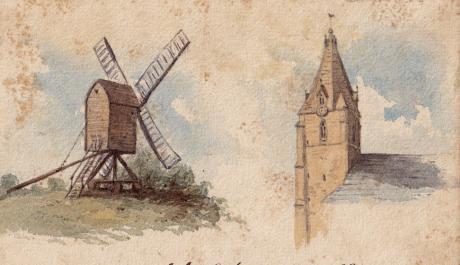inscribed " Windmill at Mansfield Woodhouse"
Mansfield Woodhouse is a settlement about 1.2 miles (2 km) north of Mansfield in Nottinghamshire, England, along the main A60 road in a wide, low valley between the Rivers Maun and Meden. Founded before the Roman Empire, it is noteworthy for its stone-built centre.
Originally separate with an urban district council, after continuous development it has become a large part of the Mansfield Urban Area. After the Local Government Act 1972, Mansfield Woodhouse and Warsop Urban District Councils merged with the Municipal Borough of Mansfield on 1 April 1974, to form a new local government area known as Mansfield District Council. Mansfield Woodhouse's economy was traditionally based on the quarrying, mining, farming and textile industries.
The Church of St Edmund (also known as St Edmund's or St Edmund King & Martyr) is on Old Manor Road, Mansfield Woodhouse, Nottinghamshire, England. It is an active Church of England parish church in the deanery of Mansfield, the Archdeaconry of Newark, and the Southwell and Nottingham diocese. Its benefice has three churches, St Edmund’s is the main parish church, also the Church of St Chad, Pleasley Vale and the Community Church on the Peafield Lane Estate.The church is recorded in the National Heritage List for England as a designated Grade II* listed building.
St Edmund's Church is partnered with nearby St Edmund's C of E Primary School. In the 1980s the school moved to its current site at Church Hill Avenue, Mansfield Woodhouse. The original building, on Welbeck Road leading down from the church, still stands and is Grade II listed. The Turner Memorial Hall, opposite the church on Church Street, serves as St Edmund's church hall and office, as well as being a community centre and the headquarters of St Edmund's scout group.
Although the church is not mentioned in the Domesday Book, it is possible that a wooden church existed at Mansfield Woodhouse in the 11th century which was destroyed by fire in 1180. A church, part timber and part local limestone, was built in 1190. A fire destroyed the village and much of the church in 1304. Work on rebuilding the church started soon after the fire in 1306. The fire is commemorated with an Appliqué wall hanging depicting the village and church burning (2004).
The church was reconstructed in 1804-1810 and subsequently heavily restored in 1847-150. This restoration was traditionally attributed to George Gilbert Scott. Pevsner was not particularly impressed by the work, describing the result in the Nottinghamshire volume of his Buildings of England series as, "neither original nor sensitive".[6] He took particular exception to the spire of the tower, calling it "very odd" and noting the lucarne windows were "so tiny that they look from a distance like a spikey finial".
Pevsner followed tradition and ascribed the building's mid-19th century reconstruction to Scott. During an assessment of the pews in St Edmund's Church by Historic England in 2007, the nineteenth century restorations of the building were re-attributed to W B Moffatt and T C Hine, rather than to Scott. The churchyard surrounds the church on all four sides, with numerous mature trees and stone boundary walls to all sides. The boundary wall facing Church Street is Grade II listed. The churchyard also contains three gravestones and a sarcophagus which are Grade II listed:


